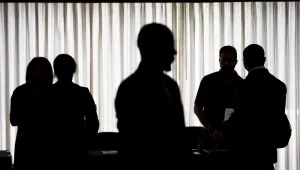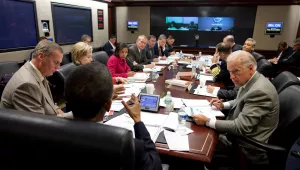Memo in report 'Confrontation or Collaboration? Congress and the Intelligence Community'
This originally apeared as a Background Memo (pp. 32-35) in the report Confrontation or Collaboration? Congress and the Intelligence Community, a publication of The Intelligence and Policy Project of Harvard Kennedy School's Belfer Center for Science and International Affairs.
Covert action is one of many foreign policy tools used by policymakers to advance national interests. Used in select international efforts, covert action encompasses a broad range of activities outside the operations of traditional intelligence collection. Sanctioned by the White House and overseen by Congress, covert action can provide results and otherwise unavailable information.
This memo provides an overview of covert action, including its legal basis, authorization and notification procedures, and historical examples.
What is Covert Action?
According to National Security Act Sec. 503 (e), covert action is, "An activity or activities of the United States Government to influence political, economic, or military conditions abroad, where it is intended that the role of the United States Government will not be apparent or acknowledged publicly." Proper covert actions are undertaken because policymakers—not the intelligence agencies—believe that secret means are the best way to achieve a desired end or a specific policy goal.
Covert action encompasses a broad spectrum of activities, but may include:
- Propaganda: Intelligence agencies covertly disseminate specific information to advance foreign policy goals. United States law prohibits, however, the use of intelligence agencies to influence domestic media and opinion.
- Political/Economic Action: Intelligence agencies covertly influence the political or economic workings of a foreign nation.
- Paramilitary Operations: Intelligence agencies covertly train and equip personnel to attack an adversary or to conduct intelligence operations. These operations normally do not involve the use of uniformed military personnel as combatants.
- Lethal Action: During times of war or armed conflict, the U.S. may need to use covert lethal force against enemies who pose a threat. The U.S. formally banned the use of political assassinations in 1976.
One distinction between covert action and other overt activities, such as traditional diplomatic or military operations, is that U.S. officials could plausibly deny involvement in the activity. This "plausible deniability," however, is predicated upon the covert action remaining secret.
- Example: American involvement in the 1961 Bay of Pigs operation could not be kept secret once the results became public, so President Kennedy publicly admitted responsibility afterwards at a White House press conference.
A Historically Controversial Tool
Covert action is a necessary—yet sometimes controversial—instrument of U.S. foreign policy. As the challenge of Soviet hegemony emerged as the principal threat to national security, the U.S. used covert action on a wide scale with the goal of combating the threat of worldwide Soviet domination. These efforts resulted in varying degrees of success.
- For instance, in 1954 the U.S. helped overthrow the Guatemalan government in order to prevent the establishment of a perceived "Soviet beachhead" in Central America and to protect U.S. economic interests in the country. This successful coup however, undermined Guatemala's efforts at democratic governance and subsequently led to decades of military rule and civil war.
- On the other hand, congressional inquiries in 1975-76 into Central Intelligence Agency (CIA) actions revealed that the Agency, among other actions, tried unsuccessfully to assassinate foreign leaders and subvert democratically-elected foreign governments.
- The 1987 Iran-Contra affair, which involved the White House's use of non-sanctioned covert action in Iran and Nicaragua in defiance of the law and without proper reporting to Congress, caused further public controversy.
Policymakers still use this foreign policy tool today. For example, covert action was an important device for U.S. national security interests soon after 9/11, as CIA paramilitary groups, U.S. Special Forces and indigenous Northern Alliance forces in 2001-2002 removed the Taliban from power in Afghanistan.
Parameters of Covert Action
U.S. law authorizes CIA to "conduct covert action activities approved by the President." The amended Executive Order 12333 (July 2008) further clarifies:
- The National Security Council (NSC) will "consider and submit to the President a policy recommendation, including all dissents, on each proposed covert action." The NSC is also tasked with conducting periodic reviews of all ongoing covert action activities, including an evaluation of the effectiveness and consistency with current national policy of such activities, as well as consistency with applicable law.
- The Director of National Intelligence (DNI) shall oversee and provide advice to the President and the NSC with respect to all ongoing and proposed covert action programs.
The Iran-Contra experience led to a more substantial and formalized role for Congress for overseeing and authorizing covert action. In the 1991 Intelligence Authorization Act, Congress established the following procedures for covert action:
- The President must determine, through a document called a presidential finding, that a covert action is necessary to support "identifiable foreign policy objectives" of the U.S. A written finding must be issued within 48 hours after the official policy decision which approves the covert action.
- The CIA Director and the heads of all departments, agencies, and entities of the Government involved in a covert action shall keep the congressional intelligence committees fully and currently informed.
- When the President determines that extraordinary circumstances make it essential to limit access to information about the covert action program, the finding may be reported to the Gang of Eight: the chairmen and ranking minority members of the intelligence committees, the Speaker and minority leader of the House of Representatives, the majority and minority leaders of the Senate, and other members of the congressional leadership that the President decides to include.
Examples of Covert Action
Operation Ajax
In 1951, Iran elected Mohammed Mossadeq Prime Minister, who ran under a platform calling for nationalizing the domestic oil industry. At the time, the United Kingdom had considerable oil interests in the country through the Anglo-Persian Oil Company. After the election, Mossadeq nationalized the oil industry, deeply upsetting the British. The U.K., under Prime Minister Winston Churchill then turned to the U.S. to help remove Mossadeq from power. Through a series of covert actions, the CIA worked with the British Secret Intelligence Service to orchestrate the fall of the Mossadeq government and to install the Shah in power in Iran.
For many years, Operation Ajax was viewed as tactically successful, as it achieved the U.S. policymakers' stated goal at the time. However, some suggest the operation was counterproductive and had long-term negative repercussions for the U.S., as the Iranian monarchy fell a generation later to the anti-U.S. clerical regime now ruling Iran.
CIA in Afghanistan 1979-89
Following the Soviet invasion of Afghanistan in December 1979, the CIA launched its largest-ever covert action program to arm the Afghan resistance. During the next ten years, the U.S., Saudi Arabia, and Pakistan provided the Afghans with billions of dollars of weapons and supplies, including advanced anti-aircraft missiles. The armaments and aid proved decisive, neutralizing Soviet air-support in the latter stages of the conflict and eventually causing the Soviets to withdraw from Afghanistan.
In another example of far-reaching consequences, however, a number of the fighters that the U.S. trained and equipped during the 1980s may be fighting American and NATO troops in Afghanistan today.
Sources
Bearden, Milt. The Main Enemy: The Inside Story of the CIA's Final Showdown with the KGB. New York: Random House, 2003.
"Executive Order: Further Amendments to Executive Order 12333." United States Intelligence Activities. 31 July 2008.
Johnson, Loch K and James Wirtz. Intelligence and National Security. New York: Oxford University Press, 2008.
Kinzer, Stephen. All the Shah's men: an American coup and the roots of Middle East terror. Hoboken, N.J.: John Wiley & Sons, 2008.
Lowenthal, Mark. Intelligence: From Secrets to Policy, 2nd Edition. CQ Press: Washington DC, 2003.
O'Brien, Michael. John F. Kennedy. New York: Macmillan, 2006.
Tenet, George. At the Center of the Storm. New York: Harper Collins, 2007.
Turner, Stansfield. Burn Before Reading: Presidents, CIA Directors, and Secret Intelligence. New York: Hyperion, 2005.
Read and download the full report:
Confrontation or Collaboration? Congress and the Intelligence Community
Download this memo:
Rosenbach, Eric and Aki Peritz. "Covert Action." Memorandum, "Confrontation or Collaboration? Congress and the Intelligence Community," Belfer Center for Science and International Affairs, Harvard Kennedy School, July 2009.







